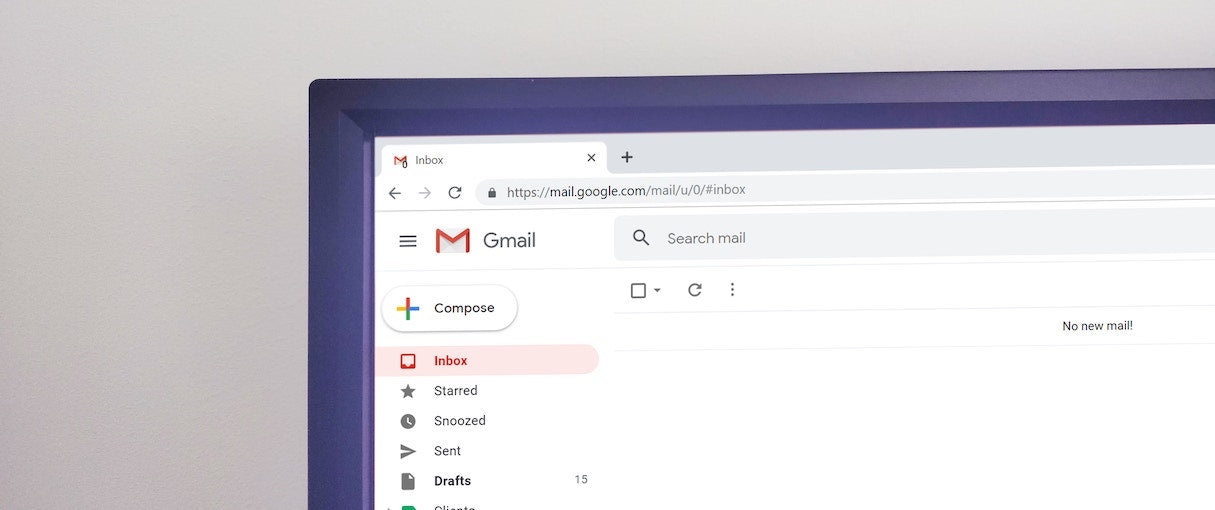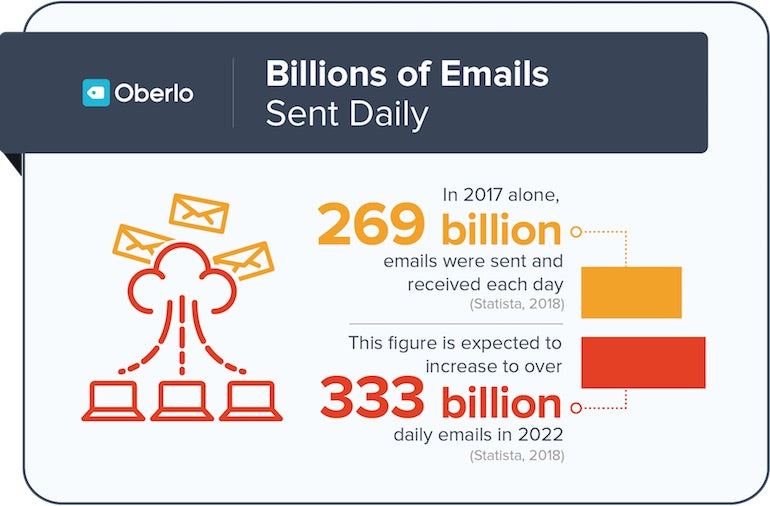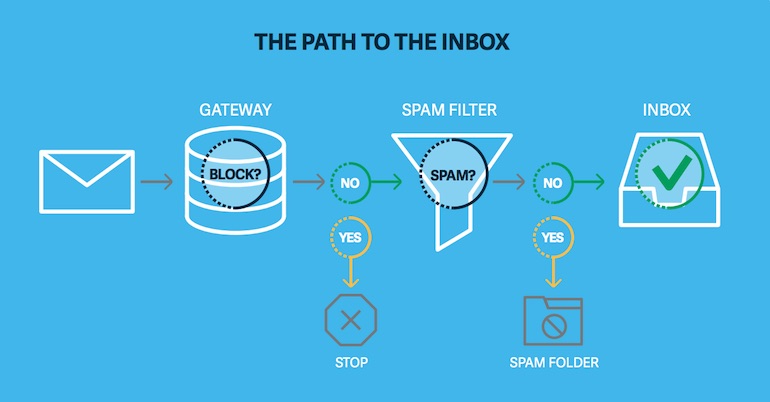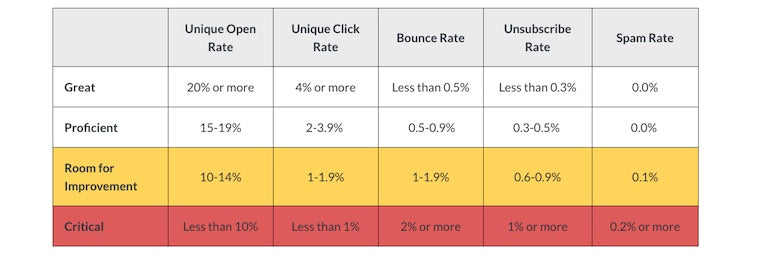
Email marketing is more relevant in today’s ecommerce landscape than ever, and it will continue to play an integral role in generating consistent revenue for the businesses you work on in the years to come. Part of the reason email is still an effective marketing channel is how often internet users send emails. According to eMarketer, nine in ten internet users send emails regularly.

Additionally, as of October 2018, Google shared that it had 1.5 billion active Gmail users. And not only is there a massive number of email users, but those users are very active—billions of emails are sent each day.

Email is still a major part of the digital world and one of the main channels in which your client’s communication takes place online, meaning it remains a powerful channel businesses should leverage to reach current and future consumers. In addition, the average return for email marketing is approximately $38 USD for every dollar spent, making it a critical pillar of every organization’s multi-channel marketing strategy. But while it remains relevant, there are different strategies and trends that organizations should adopt to maintain email marketing effectiveness.
In this article, we will break down specific steps you can do to improve your client’s email marketing strategies. We will cover what email deliverability means, how you can avoid poor deliverability, automated email flows all companies need to implement, best practices for email scrubbing, and the importance of A/B testing.
Understand email deliverability
Email marketing has evolved substantially over the years as technology has advanced, but the most critical part of email marketing remains email deliverability.
Email deliverability means your message successfully arrived in your desired recipient’s inbox, and email deliverability failure is when your message is blocked by an ISP (Internet Service Provider) or it is routed to your recipient's junk or spam folder.

Most agencies tend to overlook email deliverability until a major issue arises. They assume all of the emails sent were received unless they get a specific bounce notification. This assumption is false—according to ReturnPath’s 2017 Deliverability Benchmark Report, approximately 20 percent of commercial emails fail to reach the target’s inbox.
So how do you know if your emails will be successfully delivered? There are proven techniques you can implement to help improve your client’s email delivery rate.
One of the best ways to avoid email deliverability issues for your client’s is to make sure your organization follows best practices for your mailing lists. A few of these best practices include email validation such as double opt-in confirmation for subscribers, avoiding spam filter trigger keywords, and setting up and building IP credibility. Let’s look at each of these factors.
1. Email validation
The ultimate goal of collecting emails is to acquire real people who are interested in receiving emails from your clients. If your clients are opposed to using a double-opt solution to collect email addresses, they should consider using a secure CAPTCHA to prevent bots from trying to register using illegitimate addresses.
However, it is recommended that you help them consider using a double opt-in solution. Double opt-in confirmation means all subscribers must verify they are interested in receiving emails from your business. Users who subscribe to your client’s mailing list will submit their email address, and moments later they will be sent a follow-up email requesting they activate or reconfirm their interest in joining the mailing list.

Double opt-in confirmation is becoming the standard for collecting relevant email addresses, since you are building a list with more engaged audience members. This leads to higher open rates and increased clickthrough rates. Also, it protects your clients from fake emails leaking into their marketing lists that cost money to contact.
2. Avoid spam filter trigger keywords
Spam filters can be triggered by a wide array of reasons, resulting in your emails being diverted to the recipient’s spam folder. Organizations can avoid spam filters by crafting email subject lines that avoid spam filter trigger keywords. Some of these keywords include:
- $$$
- Free
- Act Now
- Affordable
- Cheap
- Apply Now
- Compare Rates
- Credit
- Compete For Your Business
- Incredible Deal
- Increase Traffic
- Increase Sales
- Info You Requested
- Limited Time Offer
- Online Marketing
- No Investment
- Guarantee
- Unsubscribe
- Free offer
- Free gift
- Free info
- Be Your Own Boss
- As Seen on
- Do it today
- Money back
- Member stuff
- Promise
- No fees
- No gimmicks
- No obligation
- No purchase necessary
4. Setting up and building IP credibility
Spam continues to plague our inboxes. Believe it or not, spam accounts for 45 percent of the emails sent worldwide. ISP (internet service provider) filters are constantly waging war against this assault by assessing the IP address of incoming emails and rating how trustworthy they are.
So how do you ensure your clients have strong credibility? Send quality emails to a well-vetted email list. ISPs will see their recipients are actively engaging with their emails, which signals that they are a trustworthy sender.
You or your client can also frequently scrub their marketing lists using tools such as NEVERBOUNCE, ZeroBounce, or several other solutions to ensure they are removing inactive, spammy, or illegitimate email addresses. By actively removing inactive subscribers, you will help improve engagement and open rates of your client’s emails. You may also want to review if your client’s IP address has been blacklisted. You can do this with the MXToolbox Email Blacklist Check.
Once you have taken steps with your clients to make sure their emails are landing in their customers’ inboxes, you should track email send metrics on a regular basis so you can quickly identify any issues that may come up.
You might also like: How to Write a Business Email Prospective Clients Will Never Forget.
How to measure deliverability
Gathering all the data and metrics from your email marketing platform is simple. Interpreting the findings into informed action items is much more difficult. Some metrics provide critical information about campaign performance while other metrics do not. Some business-critical metrics to consider when understanding email deliverability include:
- Delivery rate: Percentage of emails delivered to a recipient's inbox versus the number of emails sent.
- Rejected rate: Calculated subset of your bounce rate focused on messages that were marked as complaints or spam.
- Click-to-open rate: Ratio of total clicks to opens. This metric provides a clear look at the effectiveness of your email campaign.
The metrics above are beneficial to track on a high level to understand if you are having deliverability issues. From here, you would need to dig deeper into a number of issues that could be causing problems for your clients. Fortunately, numerous email service providers (ESPs) have put together some benchmark reports to further evaluate what exactly might be impacting your client’s deliverability. Remember, these are general benchmarks so use them as a gauge of your client's overall email health.

Tracking these stats month-to-month will help ensure your clients are getting the most out of their current customers as they leverage email marketing. As we move into 2020 and beyond, there are some additional factors to consider when managing and running email campaigns for your clients.
You might also like: How to Customize Shopify Email Notifications for Clients.
Email marketing best practices in 2020
Email marketing automation is a powerful customer retention tool for online retailers. The trouble is, many companies don’t know which automated email campaigns are worth prioritizing and testing, or how to design and segment emails to customers.
Three key elements to focus on moving into 2020 include leveraging micro-segments, dynamic email design, and effective email automation. Let’s look at each below.
1. Leverage micro-segmentation
When you think about segmenting email audiences, you might immediately think of age, gender, and geographic location. As email marketing continues to grow increasingly more competitive, going beyond basic segmentation in your email personalization will prove more lucrative and effective. Some micro-segmentations may include customer’s past purchases, customer lifetime value, purchase frequency, information downloaded, and what products a user has researched but hasn’t yet purchased.
For more advanced insights in who your audience is, you can dig into Google Analytics to find useful information about your client’s customers in order to send hyper-relevant emails that are high converting. Consider the audience insights you find as part of your segmentation in the design of your emails to create an even more personalized experience.
You might also like: Email Personalization: Using Analytics to Send Relevant, High Converting Emails.
2. Dynamic email design
Organizations can implement personalization techniques to provide a more unique and meaningful experience to their customers. When you implement dynamic email content, the message will automatically update based on information gathered on the receiver. These factors may include:
- Demographics like name, gender, age, etc.
- Abandoned cart product reminders
- Product recommendation emails based on shopping preferences
- Purchase patterns
Personalization with dynamic content blocks saves your organization a significant amount of time. Instead of crafting individual emails, you can send the same email to all of your email subscribers and the content blocks will update with different products, calls to action, and offers based on the recipient’s buyer persona. You will save money and your customers will have a more unique touch with your brand.
3. Effective email automation
Equally exciting is email’s potential to provide lasting value to your business with just a few starter campaigns. In fact, there are five automated email campaigns in particular that nearly every ecommerce business can benefit from implementing.
1. Abandoned cart email flow
According to the Baymard Institute, 70 percent is the average documented online shopping cart abandonment rate. Organizations can recover the lost revenue by implementing a savvy abandoned cart email sequence.
An ideal abandoned cart email flow should follow the following pattern:
- Email 1: Social proof. Sent 2 hours after the cart is abandoned and should include some social proof to get consumers excited about the products again. Star ratings or testimonials can build trust and credibility with your client’s products.
- Email 2: Key benefits. Sent 24 hours after the cart is abandoned. Highlights some of the key benefits of the product(s) they viewed to give customers more reasons to come back and complete their purchase.
- Email 3: Thank you. Sent 48 hours after the cart is abandoned. Designed to be a much softer sell since the timing may be off. Thanks them for visiting your client’s site and lets consumers know the product is still available.
You might also like: How to Build an Abandoned Cart Email Sequence.
2. New customer email flow
This email flow is centered on the first communication you have with a new first-time customer, so getting the message right is critical. In this series, you have the opportunity to develop a relationship that could lead to long-term customer value.
So, what does this email flow look like?
- Email 1: Welcome email. Crafted to welcome new shoppers into your client’s brand family. Sent immediately after purchase.
- Email 2: Check-in email. Take the time for your client to reconnect with their customers and ask them how their experience was. This allows your client to serve those who may have had a negative purchase experience with a more personal touch. Sent approximately three days after purchase.
- Email 3: Product arrival. A simple email that lets customers know when their product has arrived. This allows your client the chance to learn of potential problems with shipping if customers respond they have not received the product by the specific date noted. Sent approximately one day after the purchase was set to arrive.
- Email 4: Product review. Sent approximately five days after your client’s product was set to arrive, and requests a review. Allows your client’s customers the time needed to use your product and provide their honest feedback.
3. Re-engagement email flow
A re-engagement email series is designed to spark a renewed interest in your client’s brand in current and old customers. Over time, your client’s customers may have grown accustomed to your marketing emails, but designing an intriguing email flow can help regain their fascination with the product.
- Email 1: Discount. If your email subscribers are not engaging with your messaging, then it is imperative that you reach out and provide a reasonable discount. Provide an incentive that is irresistible.
- Email 2: Ask if they want to unsubscribe. To help you better gauge the engagement of your client’s customers, you can send an email that allows them to provide feedback on whether they would like to receive correspondence from you in the future. Set a date and let recipients know they will be removed from your email list if they do not respond within that time frame. This is a great time to remind customers of the amazing discount you previously offered.
- Email 3: Sad to see you go. Follow through with the date you set in the second email and unsubscribe unengaged users. Frame this email as a “sad to see you go” message. This is a great time to remind them you are looking out for them by not spamming their email folders with unwanted messages, and if they decide they want to come back you would welcome them with open arms.
4. Upsell and cross-sell email flow
Take advantage of email marketing to ask for an upsell. By setting up specific email flows you can open the conversation to introduce your client’s customers to more products your clients have to offer.
- Email 1: Discount recently purchased items. Send an email that highlights the specific product the customer bought followed up with a discount. You create positive feelings by displaying products they previously purchased, and you give them a compelling reason to return and spend more money than they originally thought with the discount.
- Email 2: You might also like. Suggest items that closely relate to the product they originally purchased. Showcase additional accessories, different color variations, or a clothing item that would pair well with the dress they just bought.
5. Back-in-stock email flow
If you know certain products historically sell out, set up an opt-in button on the product page for customers to receive back-in-stock emails. This simple email will lure highly primed customers back to your client’s site to commit to purchase.
Email list review
Email scrubbing is when you actively remove unengaged subscribers from email lists. How often you should scrub an email list is dependent on how often your client communicates with their customers. Organizations that send multiple emails a month may want to assess monthly; organizations that communicate once a month can scrub their list quarterly.
While you can follow the scrubbing timelines, you can also look for the following signs as an indicator you need to clean your email list:
- Increased unsubscribes
- Decreased clickthrough rate
- Decreased open rate
By scrubbing your client’s email list regularly, they will benefit from more accurate information collected, and you will be able to assess just how effective your current email marketing strategy is.
You might also like: Delivering Accessible, Usable, and High-Performance Transactional Emails for Clients.
Implement A/B testing
While businesses can follow best practices, they can also take advantage of internal research that signals what email combinations are best received among your client’s target audience. You can gather this information by performing A/B tests that target specific variables.
A/B tests are performed by sending the same email to a marketing list but manipulating one variable within the email. These variables might include subject lines, email length, time of day sent, different greetings, different tone of voice, and different colors, just to name a few.
After you have performed a wide array of A/B tests, you will be able to use your research to customize emails your audience will best engage with.
Best practices for a new year
Email remains a lucrative channel for businesses to connect and nurture leads that turn into sales. By taking the time to implement the above strategies, you’ll be better prepared to connect your client with their customers, and help your clients increase their conversion rates overall.
Read more
- 4 Conferences You Should Attend
- Build Your Ecommerce Business: Livestream
- How to Use Your Competitive Landscape to Grow Your Agency
- Raise Prices at Your Agency with this Step-by-Step Approach
- Learning How to Code, the Long Way Around
- What You Missed at Generate Conference 2014
- How to Boost Your Business’s Revenue with Ongoing Service Retainers
- 8 Usability Metrics Tech Teams Can Use To Analyze User Behaviour
- Getting the Most Out of Your Team with One-on-One Meetings
- 7 Ways to Create an Amazing Customer Experience for Your Clients’ Ecommerce Stores
What email marketing tactics will you experiment with in 2020? Let us know in the comments below.

